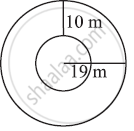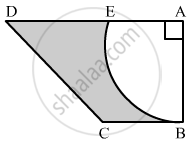Advertisements
Advertisements
प्रश्न
Find the diameter of a circle whose circumference is equal to the sum of circumference of circles with radius 10 cm, 12 cm, and 18 cm.
उत्तर
Let the radius of the circle = R cm
∴ 2πR = 2π × 10 + 2π × 12 + 2π × 18
On dividing each term by 2π, we get:
R = 10 + 12 + 18 = 40 cm
∴ Radius of the circle obtained = 40 cm
And, its diameter = 2 × Radius
= 2 × 40 cm = 80 cm
APPEARS IN
संबंधित प्रश्न
Find the circumference of the inner and the outer circles, shown in the adjoining figure? (Take π = 3.14)

Find the circumferences of a circle whose radius is 7 cm.
Find the diameter of the circle whose area is equal to the sum of the areas of two circles having radii 4 cm and 3 cm.
In the given figure, ABCD is a trapezium of area 24.5 cm2 , If AD || BC, ∠DAB = 90°, AD = 10 cm, BC = 4 cm and ABE is quadrant of a circle, then find the area of the shaded region.

The area of a circle is 38.5 cm2. The circumference of the circle is
The radii of two concentric circles are 19 cm and 16 cm respectively. The area of the ring enclosed by these circles is
Find the area and perimeter of the circle with the following :
Diameter = 77 cm
A circus tent is cylindrical to a height of 5 m and conical above it. If its diameter is 42 m and slant height of the cone is 53 m, calculate the total area of the canvas required.
A wire when bent in the form of a square encloses an area of 484cm2. If the same wire is bent into the form of a circle, find the area of the circle.
If the circumference of a circle is 82π, then the value of ‘r’ is
